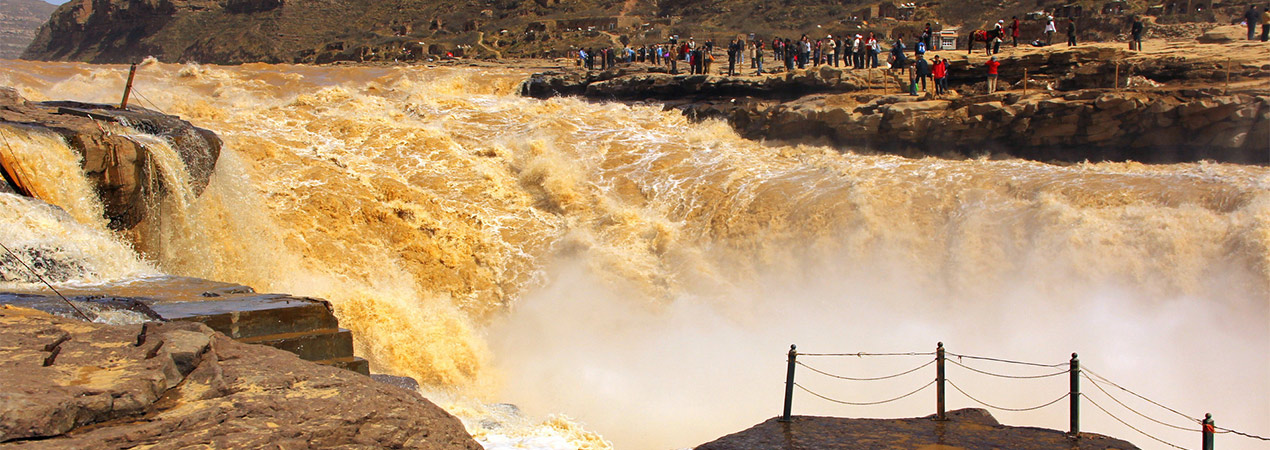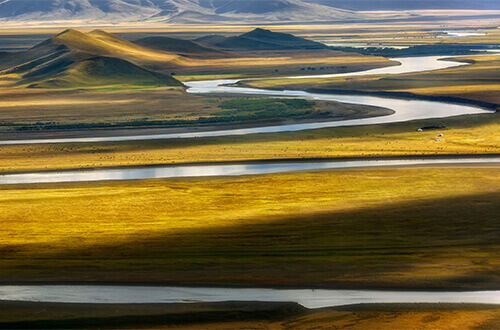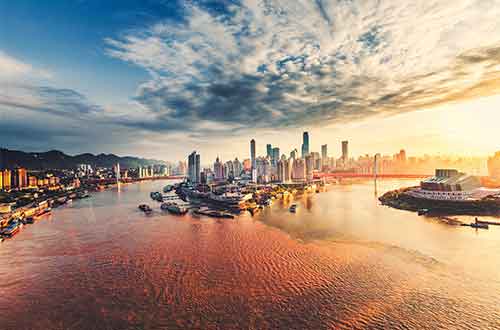Yellow River Facts

Known as the "cradle of Chinese civilization" or the "Mother River,” the Yellow River is the main source of rich fertile soil and irrigation water for the Yellow River Valley which is the birthplace of Chinese civilization. Just like many of the world's great civilizations which have grown up around mighty rivers, the recorded history of Chinese civilization begins on the banks of the Yellow River with the Xia Dynasty, which lasted from 2100 to 1600 BCE. For over 3,000 years, some major dynasties in Chinese history built their capitals in the river basin, making the region the center of politics, economy and culture in the country. Now the waterway still feeds about 12 percent of China's population, irrigates about 15 percent of arable land, supports 14 percent of national GDP, and supplies water to more than 60 cities.
On the other hand, the Yellow River is like a restless, unpredictable, and dangerous dragon. It has changed course many times since records were first kept, and its countless floods have wrought terrible destruction on the northern China region. The massive flood in 1931 cost the lives of approximately four million people. It was considered the deadliest natural disaster ever. As a result, the river has several less-positive nicknames as well, such as "China's Sorrow" and the "Scourge of the Han People." Over the centuries, the Chinese people have used it not only for agriculture but also as a transportation route and even as a weapon.
Yellow River Facts
1. Where is the Yellow River?
The Yellow River is the 2nd largest river in China. Originating in the Bayankala Mountains in Qinghai province of Western China, it flows through nine provinces and empties into the Bohai Sea near the city of Dongying in Shandong province in eastern China.
2. Where is the Yellow River on a map?
It originates in Qinghai and flows east to Lanzhou. It then takes a ‘great northern bend’ around the Ordos Desert. Near Baotou, it turns south through Shanxi province. It then flows east through Henan province and northeast through Shandong to enter the Bohai Gulf.
3. Why is the Yellow River yellow?
The middle and upper streams of the Yellow River are dominated by mountains, while the middle and lower streams are dominated by plains and hills. Because the middle section of the river flows through the loess plateau of China, it carries a lot of sediment with it. Therefore, it is also known as the river with the highest sediment content in the world. About 1.6 billion tons of sand from the Loess Plateau was washed away by the river. Thanks to the upstream conservation of soil and water along the Loess Plateau, the sand in the water has dropped to 264 million tons annually.
4. How did the Yellow River get its name?
The river got its name Huang He in Chinese because of its yellow, muddy water, which appears as it runs through the Loess Plateau in northwestern China. In early history, the Yellow River is referred to in Chinese literature simply as He (河), or "River". The province Henan’s name in fact means “South of the River”. And the Hebei province’s name means “North of the river”. The first appearance of the name "Yellow River" (黄河) is in the Book of Han (汉书) which is the history book of the Western Han dynasty (206 BCE – 9CE). But we are not sure if that refers to the river we know today.
5. How long is the Yellow River?
The Yellow River is the second longest river in China, after the Yangtze River, and the sixth longest river system in the world with an estimated length of 5,464 km (3395mi).
6. What are the major tributaries of the Yellow River?
There are various tributaries to the Yellow River ranging from the river’s source in the mountains up to where it drains into the Bohai Sea.
- Tao River (洮河)
- Huang River (湟水)
- Fen River (汾河)
- Wei River (渭河)
- Luo River (洛河)
- Qin River (沁河)
7. Yellow River – Fauna & Flora
The River is the habitat of more than 125 varieties of fish, of which one fish is included in the coveted list of the National Conservation List of Key Aquatic Wildlife. There are parasitic algae, invertebrate animals, and carnivorous fishes in the river. It has also been the natural habitat of many bird species, like Scaly-sided mergansers and the Red-crowned cranes. There is not much in the way of wildlife existing in the upper river basin due to the dense human population. However, one can spot the Tibetan antelope, Wild yak, Musk deer, and the Sikas in the lower basin. The Yellow River Frog is a frog that lives near the basin of the Ordos Loop.
The flora of the Yellow River basin varies widely depending on location. Vegetation in the high upper-course region is sparse and tundra-like, with some grassland areas at lower elevations suitable for grazing livestock.
8. What are the major cities on the Yellow River?
- Xining – provincial capital of Qinghai province, one of the major gateways to the Tibetan Plateau. You can find both mosques and Tibetan monasteries here.
- Lanzhou – provincial capital of Gansu province. It was an important communication center along the ancient Silk Road that witnessed its rise and fall.
- Yinchuan – provincial capital of Ningxia Hui Autonomous Region. Chinese Moslems, called the Hui, make up 1/3 of the population of the region.
- Baotou – largest city in Inner Mongolia, Genghis Khan’s Mausoleum is about 150km (93miles) from Baotou.
- Yan'an – Mecca of Chinese Communism. It was the wartime stronghold of the Chinese communists from the mid-1930s to 1949.
- Luoyang – capital of 13 dynasties, Longmen Grottoes is just outside the city.
- Zhengzhou – provincial capital of Henan province, Shaolin Temple is just 100km from the city.
- Kaifeng – capital of 8 dynasties, and here you can find the oldest Jewish community in China.
- Jinan – provincial capital of Shandong Province. The main site of Longshan Culture, one of the major cradles of Chinese civilization, was discovered to the east of the city.
Yellow River VS. Yangtze River
Two great rivers run through China proper: the Yellow River in the north, and the Yangtze (or Changjiang ) River to the south. In fact, most of China proper belongs to the drainage-basins of these two rivers. Both originate to the far west on the Tibetan Plateau.
| Yellow River | Yangtze River | |
|---|---|---|
| Origins | Banyan Har Mountains in Qinghai province of Western China | Tanggula Mountains in southern Qinghai province |
| Length | 5,464 kilometers | 6,418 kilometers |
| Crops | Wheat, corn, sorghum, millet and soybeans | Rice, Tea |
| Topographic feature | Alluvial plain | Mountainous and alluvial plain |
| Climate | Semi-arid and arid | Subtropical monsoon |
| Significance | Cradle of Chinese civilization It feeds about 12% of China's population. It irrigates about 15 percent of arable land. It supports 14% of national GDP, and supplies water to more than 60 cities. | The Yangtze basin houses 30% of the Chinese population. Nearly half of the country’s crop production is contributed by crops grown in the Yangtze basin. It is the principal navigable waterway in China. |
| Main Hydropower Stations(in bracket is the year to start operation) |
Sanmenxia hydropower station (1960) Liujiaxia hydropower Station (1974) Longyangxia hydropower Station (1992) Xiaolangdi hydropower Station (2001) Laxiwa Hydropower Station (2010) |
Gezhouba Hydropower Station (1981) Three Gorges Hydropower Station (2012) Xiluodu Hydropower Station (2014) Xiangjiaba Hydropower Station (2014) Wudongde Hydropower Station (2020) Baihetan Hydropower Station (2022) |
The Yellow River and the Chinese civilization
- Around 1.1 million years ago, primitive humans lived in the Yellow River basin. The Homo erectus craniums were discovered in Lantian County, Shaanxi Province.
- Around 2900 BCE, People living at Longshan (Longshan culture) area near the Yellow River in Shandong Province had become dependent on agriculture. They created black pottery for daily use. Longshan culture is an important link in the development of Chinese civilization from the independent Neolithic communities to the first dynastic states.
- The recorded history of Chinese civilization begins on the banks of the Yellow River with the Xia Dynasty, which lasted from 2100 BCE to 1600 BCE. Xia is the first dynasty in Chinese history. The beginning of the Xia Dynasty started from the legendary “Yu the Great” who was known for controlling violent floods.
- During the Shang Dynasty (1600 BCE-1046 BCE) the lower reaches of the Yellow River were inhabited and settled. People of the Shang Dynasty are believed to have used calendars and developed knowledge of astronomy and math, thanks to inscriptions on tortoise shell that have been unearthed by archaeologists.
- The Zhou Dynasty (1046-256 BCE) succeeded the Shang Dynasty. It was divided into two periods: the Western Zhou (1046-771 BCE) and the Eastern Zhou (771-256 BCE). The Western Zhou’s capital was near nowadays Xi’an, the Eastern Zhou moved the capital to Luoyang on Luo River which is a tributary of the Yellow River. During the Zhou Dynasty, the development of many notable, crucial Chinese philosophies began to take hold. This list would include Confucianism, Daoism, and Legalism.
- In 221 BCE, Emperor Qin Shi Huang conquered the other warring states and established the unified Qin Dynasty. The victory of Qin was partly accredited to the Zhengguo (Chengkuo) Canal. The canal connected the Wei River (a tributary of the Yellow River) and the Jing River. It irrigated 27,000 square kilometers of additional agricultural land, providing the kingdom with sufficient resources to increase the size of its already massive armies.
-
In 724, a bridge was constructed over the Yellow River at Pujin. It linked Shaanxi and Shanxi provinces. The Pujin Bridge took the form of wooden planks affixed to giant iron chains over the river. The chains were anchored securely in huge iron oxen sculptures on the banks. On the back of each ox was a rod to which the chains were attached.
About one third of China's annual iron production went into this project. Each region had to send iron ore to the capital where giant furnaces converted it to cast iron. There were eight oxen, each about 3 meters (10 feet) long and 1.9 meters (6 feet) high. They weighed about 70 tons each and were cast as a single piece – an amazing achievement for the time. Oxen were chosen because the animal is believed to have the power to control floods. This is from the system of Five Elements where the ox represents the earth element that controls the water element.
- In 1344, a Yellow River flood resulted in a large number of casualties. The imperial court mobilized 260,000 common people to deal with the Yellow River. During the course of the Yellow River project, corruption was a frequent problem, and the relief money went directly into the pockets of corrupt officials. That led to even bigger public discontent with the authorities. Finally the relief project helped fuel rebellions that led to the founding of the Ming dynasty.
- In 1642, Kaifeng city had been under siege by Li Zicheng's peasant rebel army for six months. The city's governor decided to break the dikes in the hope of washing away the besieging army (some records claimed that it was the rebel army that broke the dikes). Instead, the river engulfed the city, killing almost 300,000 of Kaifeng's 378,000 citizens and leaving the survivors vulnerable to famine and disease. The city was abandoned for years following this devastating mistake. The Ming Dynasty fell to Manchu invaders, who founded the Qing Dynasty just two years later.
- In 1887, a major Yellow River flood killed an estimated 900,000 to 2 million people, making it the third-worst natural disaster in history.
- The 1931 Yellow River flood killed about 4 million people, making it one of the deadliest floods in all of human history.
- The 1938 Yellow River flood (literally "Huayuankou embankment breach incident") was a flood created by the Nationalist Government in central China during the early stage of the Second Sino-Japanese War in an attempt to halt the rapid advance of Japanese forces. In June 1938 China's Nationalist government breached a major Yellow River dike in a drastic attempt to use flooding to slow the Japanese invasion. The strategic breach caused the Yellow River to abandon the northern course it had followed since 1855, and its new southeastern course led to eight years of catastrophic flooding. An official Nationalist post-war commission estimated that 800,000 were drowned, which may be an underestimate.
- In 1943 a flood washed away the crops in Henan Province in central China, leaving 3 million people to starve to death.
- In 1946, The Yellow River Conservancy Commission (YRCC) was established in Heze in Shandong Province. It has now grown to an organization of 30,000 staff and has branches in all the provinces of the Yellow River basin. Its main functions are to: Implement and supervise the enforcement of Water Laws and other water-related Acts. Monitor and control soil erosion in key areas of the Loess Plateau. Formulate guidelines for the conservation of the rivers, lakes, estuary, and coastline within Yellow River basin.

 Highlights Along the Yellow River
Highlights Along the Yellow River  Poems About Yellow River
Poems About Yellow River  Songs About the Yellow River
Songs About the Yellow River  The Yangtze River
The Yangtze River